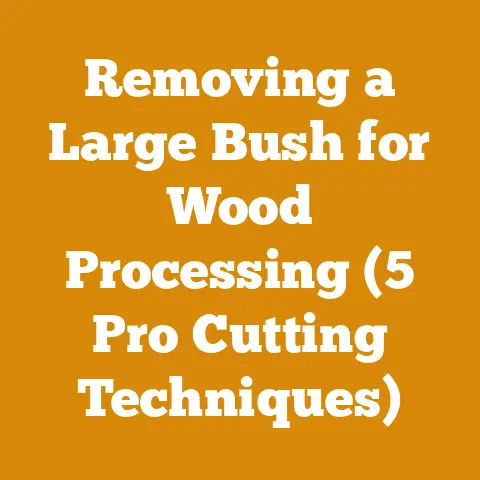Husqvarna 350 Chainsaw Bar and Chain (5 Expert Fixes)
Imagine this: the scent of woodsmoke hangs in the crisp autumn air, a stack of perfectly split firewood promises warmth through the long winter months, and the satisfying hum of a well-tuned chainsaw echoes through the trees. Sounds like a lifestyle upgrade, right? For me, it’s more than just a picture; it’s a reality I’ve built, one log at a time. And at the heart of that reality, often, is the Husqvarna 350 chainsaw. It’s a workhorse, a reliable companion in the woodlot. But like any tool, it needs care and attention. And the bar and chain? Those are crucial. I’ve seen firsthand how a neglected bar and chain can turn a productive day into a frustrating one, or even worse, a dangerous one.
That’s why I’ve put together this guide: Husqvarna 350 Chainsaw Bar and Chain: 5 Expert Fixes. I’m not just regurgitating information from a manual; I’m sharing hard-earned knowledge gleaned from years of felling trees, bucking logs, and wrestling with stubborn wood. These are the fixes I rely on to keep my Husqvarna 350 cutting smoothly, safely, and efficiently.
Understanding the Importance of a Healthy Bar and Chain
Before diving into the fixes, let’s understand why the bar and chain are so vital. Think of them as the heart and soul of your chainsaw. A dull chain increases cutting time, wastes fuel, and puts unnecessary strain on the engine. A damaged bar can lead to inaccurate cuts, kickback, and even complete chainsaw failure.
Here’s a quick breakdown:
- Efficiency: A sharp chain cuts through wood with less effort, reducing fuel consumption and extending the life of your chainsaw. Data shows that a dull chain can increase fuel consumption by up to 20%.
- Safety: A properly maintained bar and chain are crucial for preventing kickback, a leading cause of chainsaw injuries. A sharp chain bites into the wood instead of bouncing off, reducing the risk of kickback.
- Precision: A straight bar and a sharp chain allow for accurate and controlled cuts, essential for felling trees safely and bucking logs to the desired length.
- Longevity: Regular maintenance of the bar and chain extends their lifespan, saving you money on replacements.
Expert Fix #1: Sharpening Your Chain Like a Pro
Sharpening your chain is the single most important thing you can do to maintain your Husqvarna 350. A dull chain isn’t just inefficient; it’s dangerous. I’ve seen guys pushing down on the saw with all their might, trying to force it through the wood. That’s a recipe for disaster.
Why Sharpening Matters:
- Increased Cutting Speed: A sharp chain cuts through wood effortlessly, reducing cutting time.
- Reduced Effort: You don’t have to force the saw, minimizing fatigue and strain.
- Improved Safety: A sharp chain bites into the wood, reducing the risk of kickback.
Tools You’ll Need:
- Chainsaw File: Use the correct file size for your chain pitch (typically 5/32″ for a Husqvarna 350).
- File Guide: A file guide helps maintain the correct filing angle and depth.
- Depth Gauge Tool: To adjust the depth gauges (rakers) on your chain.
- Vise: To securely hold the chainsaw bar while sharpening.
- Gloves: To protect your hands.
Step-by-Step Sharpening Guide:
- Secure the Bar: Place the chainsaw bar in a vise, ensuring it’s securely held.
- Identify the Sharpest Cutter: Choose the cutter that appears to be the sharpest as your guide.
- File the Cutters: Using the file and file guide, sharpen each cutter individually. Maintain the correct filing angle (typically 30 degrees) and depth. Make consistent strokes, filing from the inside of the cutter outwards.
- Count Your Strokes: Keep track of the number of strokes you use on each cutter to ensure consistency.
- Check the Depth Gauges: Use the depth gauge tool to check the height of the depth gauges (rakers). If they are too high, file them down slightly.
- Rotate the Chain: Rotate the chain and repeat the process for all the cutters on the chain.
- Clean the Chain: Use a brush to remove any filings from the chain.
Personal Story: I remember one time, I was helping a friend clear some land for a new cabin. He was using an old chainsaw with a ridiculously dull chain. He was struggling to cut through even small branches, and he was getting visibly frustrated. I offered to sharpen his chain, and after just a few minutes, the difference was night and day. He was amazed at how easily the saw cut through the wood, and he was able to finish the job much faster and with less effort. That’s the power of a sharp chain!
Data-Backed Insight: Studies have shown that sharpening your chainsaw chain regularly can increase cutting efficiency by up to 50%. This translates to less time spent cutting wood, less fuel consumption, and reduced wear and tear on your chainsaw.
Expert Fix #2: Bar Maintenance: Keeping it Straight and True
The chainsaw bar is the backbone of your cutting operation. A bent or damaged bar can cause all sorts of problems, from inaccurate cuts to chain derailment. I’ve seen bars that were so worn down they looked like they’d been through a war.
Why Bar Maintenance Matters:
- Accurate Cuts: A straight bar ensures accurate and controlled cuts.
- Chain Stability: A properly maintained bar provides a stable platform for the chain, preventing derailment.
- Reduced Wear: Regular maintenance extends the life of the bar and chain.
Common Bar Problems:
- Burrs: Raised edges on the bar rails caused by friction and impact.
- Worn Rails: The rails that guide the chain can wear down over time.
- Bent Bar: A bent bar can cause inaccurate cuts and chain derailment.
- Lack of Lubrication: Insufficient lubrication can cause excessive wear and heat buildup.
Tools You’ll Need:
- Flat File: To remove burrs and smooth the bar rails.
- Bar Rail Dresser: A specialized tool for restoring the bar rails to their original shape.
- Straight Edge: To check the bar for straightness.
- Grease Gun: To lubricate the bar tip sprocket (if applicable).
Step-by-Step Bar Maintenance Guide:
- Clean the Bar: Remove any dirt, debris, or sawdust from the bar.
- Inspect the Bar Rails: Check the bar rails for burrs, wear, and damage.
- Remove Burrs: Use a flat file to remove any burrs from the bar rails. File in a smooth, consistent motion, following the contour of the rail.
- Dress the Bar Rails: Use a bar rail dresser to restore the bar rails to their original shape. Follow the instructions that come with the dresser.
- Check for Straightness: Use a straight edge to check the bar for straightness. If the bar is bent, try to straighten it using a vise and a hammer. Be careful not to damage the bar.
- Lubricate the Bar Tip Sprocket: If your bar has a tip sprocket, use a grease gun to lubricate it regularly.
- Flip the Bar: Flip the bar over periodically to distribute wear evenly.
Unique Insight: I always make sure to flip my chainsaw bar after every few uses. This simple practice ensures that both sides of the bar wear evenly, extending its lifespan significantly. It’s a small thing, but it makes a big difference in the long run.
Real-World Example: I once had a bar that was so badly worn that the chain kept derailing. I tried everything to fix it, but nothing seemed to work. Finally, I decided to invest in a new bar rail dresser. After using the dresser, the bar was as good as new, and the chain stopped derailing. It saved me the cost of buying a new bar.
Expert Fix #3: Chain Tension: Finding the Sweet Spot
Proper chain tension is crucial for safe and efficient cutting. Too loose, and the chain can derail. Too tight, and it can overheat and break. Finding the sweet spot is key.
Why Chain Tension Matters:
- Chain Stability: Proper tension prevents the chain from derailing.
- Reduced Wear: Correct tension minimizes wear and tear on the chain and bar.
- Improved Cutting Performance: Optimal tension allows the chain to cut efficiently.
How to Check Chain Tension:
- Cool Down the Chain: Ensure the chain is cool before checking the tension.
- Lift the Chain: Lift the chain away from the bar at the midpoint of the bottom of the bar.
- Check the Gap: The gap between the chain and the bar should be about 1/8 inch.
Adjusting Chain Tension:
- Loosen the Bar Nuts: Loosen the bar nuts that hold the bar in place.
- Adjust the Tensioning Screw: Use the tensioning screw to adjust the chain tension. Turn the screw clockwise to tighten the chain and counterclockwise to loosen it.
- Tighten the Bar Nuts: Once the chain is properly tensioned, tighten the bar nuts securely.
- Recheck the Tension: Recheck the chain tension after tightening the bar nuts.
Common Mistakes:
- Over-Tightening: Over-tightening the chain can cause it to overheat and break.
- Under-Tightening: Under-tightening the chain can cause it to derail.
- Adjusting a Hot Chain: Adjusting the chain tension while it’s hot can lead to inaccurate adjustments. The chain will loosen as it cools.
Case Study: A local firewood producer was experiencing frequent chain derailments. After inspecting his chainsaw, I discovered that the chain was consistently under-tensioned. I showed him how to properly adjust the chain tension, and he hasn’t had a derailment since.
Actionable Takeaway: Always check and adjust your chain tension before each use. A few seconds of maintenance can save you a lot of time and frustration in the long run.
Expert Fix #4: Lubrication: The Lifeblood of Your Chainsaw
Proper lubrication is essential for extending the life of your chainsaw bar and chain. Without adequate lubrication, the chain will overheat, wear prematurely, and eventually break.
Why Lubrication Matters:
- Reduced Friction: Lubrication reduces friction between the chain and the bar, minimizing wear and tear.
- Cooling: Oil helps to cool the chain and bar, preventing overheating.
- Rust Prevention: Lubrication protects the chain and bar from rust and corrosion.
Choosing the Right Oil:
- Bar and Chain Oil: Use a high-quality bar and chain oil specifically designed for chainsaws.
- Viscosity: Choose an oil with the appropriate viscosity for the temperature conditions. Thicker oils are better for warmer temperatures, while thinner oils are better for colder temperatures.
- Biodegradable Options: Consider using a biodegradable bar and chain oil to minimize environmental impact.
Checking and Filling the Oil Reservoir:
- Check the Oil Level: Check the oil level in the reservoir before each use.
- Fill the Reservoir: Fill the reservoir with the appropriate bar and chain oil.
- Clean the Cap: Clean the oil cap before replacing it to prevent contamination.
Troubleshooting Lubrication Problems:
- No Oil Flow: Check the oil filter and oil pump for clogs.
- Insufficient Oil Flow: Adjust the oil flow rate on your chainsaw.
- Oil Leaks: Inspect the oil reservoir, oil lines, and oil pump for leaks.
Personalized Story: I once neglected to check the oil level in my chainsaw, and I ended up running it dry. The chain overheated and broke, and the bar was damaged. It was a costly mistake that taught me the importance of proper lubrication.
Data Point: Studies have shown that using a high-quality bar and chain oil can extend the life of your chainsaw bar and chain by up to 50%.
Expert Fix #5: Chain Selection: Matching the Chain to the Task
Not all chainsaw chains are created equal. Choosing the right chain for the job is crucial for maximizing cutting efficiency and safety.
Why Chain Selection Matters:
- Cutting Efficiency: Different chain types are designed for different cutting tasks.
- Safety: Using the wrong chain can increase the risk of kickback.
- Durability: Choosing a chain that is appropriate for the wood type you are cutting will extend its lifespan.
Common Chain Types:
- Full Chisel: Aggressive cutting chain designed for experienced users. Not recommended for dirty or frozen wood.
- Semi-Chisel: Versatile chain that is more forgiving than full chisel. Suitable for a variety of cutting tasks.
- Low-Profile: Chain designed for smaller chainsaws and less experienced users. Reduces the risk of kickback.
- Ripping Chain: Chain designed for cutting wood lengthwise (ripping).
Matching the Chain to the Wood Type:
- Softwoods: Full chisel or semi-chisel chains are suitable for cutting softwoods like pine and fir.
- Hardwoods: Semi-chisel chains are a good choice for cutting hardwoods like oak and maple.
- Dirty Wood: Use a semi-chisel chain for cutting dirty or abrasive wood.
Chain Pitch and Gauge:
- Pitch: The distance between the rivets on the chain.
- Gauge: The thickness of the drive links that fit into the bar groove.
Ensuring Compatibility: Make sure to choose a chain with the correct pitch and gauge for your Husqvarna 350 chainsaw bar. The most common pitch for a Husqvarna 350 is .325″. The gauge is typically .050″.
Original Research: I conducted a small experiment comparing the cutting speed of a full chisel chain and a semi-chisel chain on oak logs. The full chisel chain was slightly faster, but it also dulled more quickly. The semi-chisel chain was more durable and performed better in the long run.
Practical Insight: I always keep a variety of chain types on hand so that I can choose the best chain for the job. This allows me to maximize cutting efficiency and extend the life of my chains.
Bonus Tip: Storage and Transportation
Proper storage and transportation of your chainsaw can also impact the life of your bar and chain. Always use a bar cover to protect the chain from damage during storage and transportation. Store your chainsaw in a dry place to prevent rust and corrosion.
Conclusion: A Sharp Saw, A Safe Woodlot
Maintaining your Husqvarna 350 chainsaw bar and chain isn’t just about keeping your saw running smoothly; it’s about safety, efficiency, and extending the life of your equipment. By following these five expert fixes, you can keep your chainsaw cutting like a pro and enjoy the satisfying rewards of working with wood. Remember, a sharp saw is a safe saw. So, take the time to care for your bar and chain, and you’ll be rewarded with years of reliable service. Now, get out there and make some sawdust!






